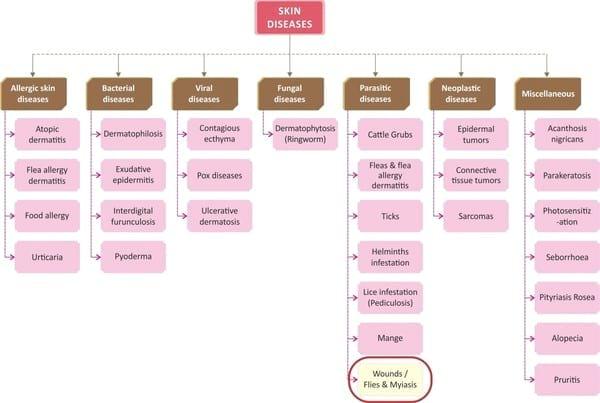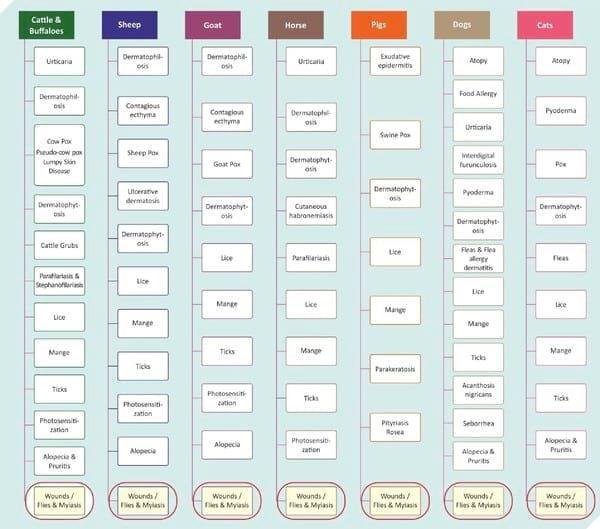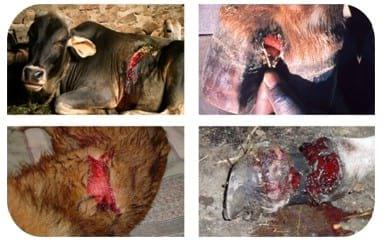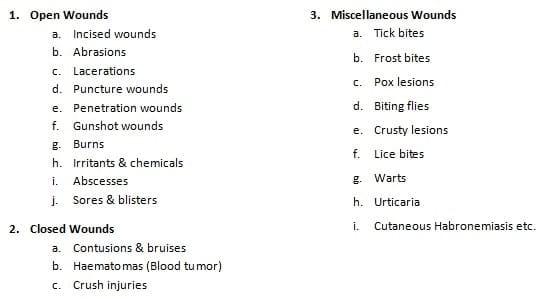SKIN – The First and Foremost Bastion
Published: December 9, 2014
By: Dr. Zafar Ahmad, Product Manager, Natural Remedies Pvt. Ltd, Bangalore
Skin also known as the Integumentary System is, in fact, the largest organ of the body. It performs many functions that are important in maintaining homeostasis in the body. The skin also protects the body from physical damage and bacterial invasion. It’s one of the first systems that get affected when an animal becomes sick, so it is important for veterinarian to have a sound knowledge of the structure and functioning of the skin. Huge number of diseases across all species affects the dermatological system and in majority of instances they look alike with similar clinical findings. Diagnosis by a veterinarian becomes a major challenge. The effect of skin problems on animal productivity also varies from mild irritations to rapid death, with all kinds of in-between stages affecting the productivity and comfort of the animals. It really pays to pay close attention to minute details of skin for the overall health and comfort of animals.
Skin is among first of the organs which gets instantaneously affected when an animal becomes sick. It interfaces the environment as a first line of body defense to external factors. It is an imperative for veterinarians to have a sound understanding of the structure and functioning of the skin to quickly recognize and treat the signs of disease. Skin, also known as integumentary system is the largest organ of the animal body. Having a complex structure, it is responsible for maintaining homeostasisin the body. Regulating body temperature, providing sensatory perception, protecting body from physical damages as well as microbial invasion & production of vitamin D are among the most critical functions of the skin.
Contributing 12-24% of the total body weight, skin is the most noticeable organ to a veterinarian, which often provides ready clues to the health of an animal. Healthy animal will have a clean, glowing & flexible skin whereas ill health reveals an abnormal colour or texture of skin.
Challenges for Skin
Skin faces rampant challenges day in and day as a first line of body defense against an array of agents including irritants, burns, allergens, trauma, and infection by bacteria, yeast, fungi, virus, or parasites.
Inflammation of skin is collectively referred to as dermatitis and it may manifest as pruritis, scaling, erythema, thickening or lichenification of the skin, hyperpigmentation, oily seborrhea, odour, hair loss and wound. It often gets complicated by secondary bacterial and yeast infections posing major challenge in treatment and healing of skin disorders.
As dermatitis prolongs, chronic changes will make acute signs of inflammation to subside. Lichenification of skin, hyperpigmentation, scaling, seborrhea, dryness of skin is among the changes visible in chronic dermatitis. Identification and treatment of underlying cause and treatment of secondary infections or other complications is critical in resolution of dermatitis.
Dermatological Problems
Skin diseases in majority of instances look alike with similar clinical findings. Diagnosis by a veterinarian becomes a major challenge, if the diseases are not differentiated by working through diagnostic flow charts and elimination of non-probable causes, finally arriving at the most probable or exact diagnosis. As a vet embarks upon concerted differential diagnosis list based on the major dermatological problems or symptoms, he can choose more appropriate diagnostic tests to pin-point the exact etiology. Diagnosis involves utilization of tools such as detailed patient history, physical examination, laboratory diagnostic tests (skin scrapings, hair examination, cytology, bacterial & fungal cultures, biopsy, blood & urine tests etc.)
A comprehensive list of various skin diseases affecting domestic and pet animals is shown in the following diagram.
Aetiology based classification of skin diseases

Species-Wise Classification of Skin Diseases

Wound
Wound stands out as the most significantly manifested clinical sign in majority of dermatological problems. Wound may be primary clinical sign as a result of etiological injury/damage to the skin or it may be secondary due to pruritis or itching whic h forces animal to scratch and resultant damage. However, it may be said that any dermatological problem always has a tendency to cause wounds in animals. Wounds are the physical injuries which result in opening or breaking in the skin causing discontinuity in the continuity of skin.

Wound Classification and Causes:

Based on the nature of the repair process; wounds can also be classified as acute or chronic wounds.
Acute wounds are usually tissue injuries that heal completely, with minimal scarring, within the expected time frame, usually 8–12 weeks.
Chronic wounds on the other hand arise from tissue injuries that heal slowly, that is have not healed beyond 12 weeks and often reoccur. Such wounds fail to heal due to repeated tissue insults or underlying physiological conditions.
Myiasis
Myiasis is the infestation of live vertebrate animals with dipterous larvae, which, at least for a certain period, feed on the host's dead or living tissue, liquid body substances, or ingested food. Myiasis remains an unresolved problem for animal production and is responsible for severe economic losses through poor hide quality, reduced weight gain, loss of fertility and reduction in the production of milk.
Economic Importance of Skin Diseases
Skin disorders in domestic and pet animals are very common and they severely affect productivity and health. A chronic, lingering skin problem may severely affect the performance of animal in terms of productivity and reproductive efficiency.
If animal is suffering from any kind of wound, it will not be in a position to have sustained milk production, so, eventually leading to economic loss.
If animal suffers from maggotted wound, it not only shows signs of discomfort, but also has to fight against maggots & impending bacterial infection. The energy utilized for this purpose is considerably high, which results into drop in milk production as well as have zoonotic importance.
The multi-factorial etiological factors associated with skin problems make it difficult to treat the same under field/farm conditions. More so if the wounds are infected, the chances of maggot infestation and microbial infection are very high in field condition due to unhygienic farm conditions. If maggots are not completely destroyed, the delay in wound healing will have significant impact on the cost of treatment and milk production.
The first and paramount step is to identify the possible etiological factor for the disease and treat it accordingly. It shouldn’t be forgotten to provide first course of treatment in skin wounds with an effective topical agent capable of effective fly repellant and maggoticidal action.
Management of Skin Diseases
The treatment of skin disease will vary, but will depend on treating the underlying cause at the same time as treating the secondary symptoms. Most treatments will be based on test results, but often include parasite control (anthelmintics and parasiticides), antibiotics, or medicated shampoos, pour-on’s and conditioners. Other useful treatments include anti-inflammatory drugs (drugs to decrease the redness/heat/pain/swelling response), antihistamines, topical sprays, topical ear cleaners and medicated drops, immune suppressive drugs (for autoimmune diseases and atopy), hypoallergenic diets or dietary supplements (omega-3,6 fatty acids), or possibly surgery (to drain abscesses, hematomas, or remove tumors).
In most cases, the prognosis is excellent for providing animal with relief and restoring comfort, however most skin disorders involve control rather than cure. Often in chronic cases, a due diligence, commitment and constant open communication of farmer/client with veterinarian is critical to long-term success.
Looking into economic impact of the skin diseases it becomes highly imperative for a veterinarian to identify the root cause of the problem. Identification of aetiology is highly critical for satisfactory prognosis of the condition. Differential diagnosis holds the key and thereby this article necessitates all the possible occurring skin conditions both aetiology-wise and species-wise. We hope that this article will help veterinarians to better understand dermatological problems of domestic and pet animals.
Related topics:
Authors:
Natural Remedies Private Limited
Recommend
Comment
Share
22 de abril de 2015
I totally agree with the point that skin disease will vary and this article will really help to understand dermatological problems of domestic and pet animals. So have a look at http://www.naturalbraid.com/.
Recommend
Reply

Would you like to discuss another topic? Create a new post to engage with experts in the community.






